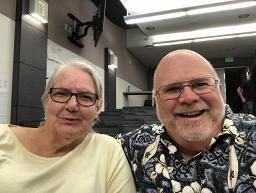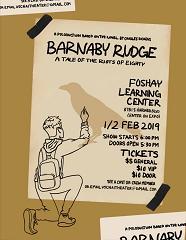This article originally appeared in the January 2019 GRAD Greetings Newsletter. Written by Miriam Branch. Photos by Tim Clark and Miriam Branch. Republished with permission from the Greater Riverside Area Dickens Fellowship.





When I was 14 years old, I started to read my very own paperback copy of Pickwick Papers. I had read Oliver Twist a year or so before, and had gobbled up A Tale of Two Cities just a few months earlier. On page 31 of the new tome, I encountered sedulous. On page 32, there was assiduously. I asked the friend’s teacher-mother who was driving me to school what the words meant. She read the passage and deduced “hard work,” but suggested I consult an unabridged dictionary for the next new word. I had 800 pages left and was not about to make frequent trips to my unabridged. The book went into my bookcase—and remains there, unread, to this day.
Fifty-six years later, I know many more words and have read most of Dickens’ novels, thanks largely to the stunning stage adaptation of Nicholas Nickleby in 1980. I’ve sat through all nine hours of four or five stagings, and bought copies of the novels I didn’t own in one shopping trip, after seeing the first televised version. Reading Dickens in solitude is a pleasure. Even more pleasurable is reading his books aloud, to a group assembled for the purpose of listening, or of reading along. I had participated in marathon readings at UCLA’s English Department at least six times, but it had been years.
So, when Tim Clark announced that there would be a marathon reading of Barnaby Rudge on September 29, 2018, at USC, for the students of the AP English class at the Foshay Learning Center, I had to be there. Today’s students can consult their Smartphones for definitions, but they need to hear what loving Dickens is like if they are to make their way through all 700+ pages.
I had hoped to be there by 2 pm for the whole marathon, but after a late start and a full circuit of the campus to find the street with the parking structure, I parked and made my way to the Taper Building. I could tell I was in the right place when I saw a banner through the window with a young man, arm raised, and the words Barnaby Rudge. I entered a white lecture hall, with 50-60 teenagers in identical black T-shirts, each with the latest Penguin edition of Barnaby Rudge, some with pillows, many with new stuffed animals to cheer them on, some with blankets and water bottles. The walls were covered with pictures relating to the novel, done by the students. Projected behind the reader on stage were pages from the original edition of the book, including illustrations. The students were immersed in the book.
Sponsored by The Dickens Project, the marathon was intended as part slumber party, part book club, and part university lecture, with volunteer readers culled from The Dickens Project, attendees of the Dickens Universe, other Foshay teachers—and Ms. Jacqueline Barrios, the AP English teacher and lead reader.
The marathon was on Chapter Three of the 12 chapters scheduled to be covered when I arrived just before 4 pm. One of the students was reading. “Project!” directed Ms. Barrios. The student increased her volume. I was next up for Chapter Four. When I got to the part detailing the Varden house, Ms. Barrios addressed the students: “What’s happening here? What is Dickens doing?” “He’s describing a house,” answered a student. “Yes. It’s a long description. Dickens spends a lot of time describing places that are important in the book. Put a star by that.” Antoinette Pippin, a Foshay teacher I had met at Universe, came in as I was reading. She was assigned Chapter Six and delivered a stunning version of Grip, the “idiot” Barnaby’s prescient and loquacious raven, from his first “Halloa!” Ms. Barrios suggested not only that the students put a star by the passage but that they might want to look up some of the research being done on animal intelligence, and specifically that of corvids.
After a much-needed break, with hot dogs and snacks furnished by mothers and siblings (I had my first Hostess Sno-Ball in 50 years!), the reading continued with Chapter Seven. “Something important is happening here,” interrupted Ms. Barrios. “Dickens is introducing a new character. Put a big star here.” The reader introduced us to the redoubtable Mrs. Varden. At the end of the chapter, Ms. Barrios asked what Mrs. Varden was like. “Manipulative. Dishonest,” answered one of the girls. At the end of the chapter is a complex picture of Barnaby’s dream life. What to make of it?
Ms. Barrios reminded the students that their eyes should be on the book. No nodding off. Tim Clark had arrived and was given Chapter Eight to read, the meeting of disgruntled apprentices. The students were getting restless. There were four more chapters. Another reader handled the formal introduction of Miss Miggs, Chapter Nine. Ms. Barrios again directed the students to “Put a big star by that.” The reader for Chapter Ten took us back to the Maypole and the characters I had missed meeting by being late. Something of a mystery appeared to be afoot, and two enemies might be about to meet after many years. The event was running late, so Ms. Barrios read the final two chapters, handling the last in a way that would make Jamie Buck envious.
With the end of Chapter Twelve, the students were reminded that their assignment was to read the next 120 pages. I shouted at one of the boys to look up the meaning of Barnaby. The students removed their drawings from the walls, and we all adjourned to the courtyard, where a new group of mothers and siblings was standing with pizza and salad. Glorious!
I don’t know about the students, but I’m revved to read the novel, especially with all the talk of mobs in the news lately. And I recommend that if reading aloud and being around bright students interests you, you may want to put a big star on your calendar for next year. I hope to see the show the students put together from the book at the end of the school year.
You can follow class progress on social media: @uscnaitheater #barnabylab
For more details about the show and our pre-production festival, including a schedule and in-depth stories about students’ experiences in BarnabyLab, please visit litlab.ucsc.edu
